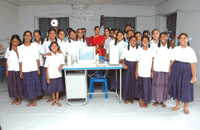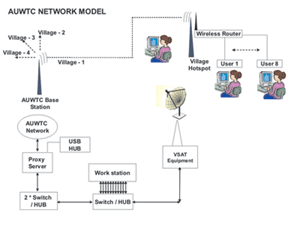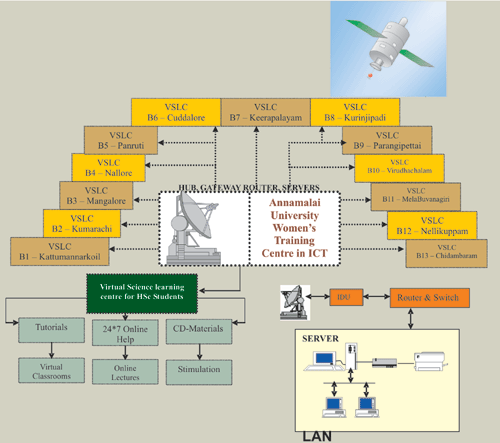The article presents the Virtual Science Learning Centre (VSLC) model setup by Annamalai University for strengthening and popularising science information and education among rural youth and school students in Cuddalore district in the Southern Indian state Tamilnadu. Although several remarkable achievements have occurred in the sphere of science education system in India in the last decade, studies have reported that polarisation exists between the urban and the rural students, and situation is still worse in the case of girl students in the rural set up who would like to start their academic pursuits as the first generation candidates. In an attempt to address this, VSLC promotes the capacity building, confidence building and the personality development of the rural youth especially the young girl students. It builds a “Partnership in Learning” (PiL) Programme between the university and school girl students community through telecentres and web portal.
 There is a growing tension among majority of the rural students in not being able to cope with the expected level of mastery in certain core subjects like Science, Mathematics and English at the HSC examination levels and also to prepare them for the entrance examination in order to get access to institutes of higher education of some order. “Partnership in Learning'- is an attempt of Annamalai University in Southern India to address this problem statement, the goal of which is to design and develop the ICT based Information Support system to enhance the skill and expertise of High School Students (10+2) in the Tsunami Affected Regions of Cuddalore district. It is intended to deliver science Educational contents based on their curriculum, through various network delivery channels.
There is a growing tension among majority of the rural students in not being able to cope with the expected level of mastery in certain core subjects like Science, Mathematics and English at the HSC examination levels and also to prepare them for the entrance examination in order to get access to institutes of higher education of some order. “Partnership in Learning'- is an attempt of Annamalai University in Southern India to address this problem statement, the goal of which is to design and develop the ICT based Information Support system to enhance the skill and expertise of High School Students (10+2) in the Tsunami Affected Regions of Cuddalore district. It is intended to deliver science Educational contents based on their curriculum, through various network delivery channels.
It is proposed to mobilise the existing learning resources and to customise the pedagogy with the support of voluntary work from the university academic community along with the district administration and corporate. The purpose is to tailor-made the contents to suit the requirements of student from different socio-economic communities.
Building a synergy between community, university, industry and high school system
The aim of this project is to establish a twinning programme between the university and the rural schools surrounding the university in order to strengthen the university-community learning centre activities with the sole motto of empowering the girl students belonging to the deprived and downtrodden communities in the rural regions who cannot afford to continue their school education.
The objective is to build a university based online-support system through special coaching to the girl students pursing higher secondary education at Cuddalore District in Tamilnadu. The reason for choosing this particular region can be explained by the fact that it is one of the 13 districts in the state of Tamilnadu (World Bank Report) where the gender gap is prominent in the higher secondary schools. Out of the 1,13,268 students enrolled in 97 schools in Cuddalore District, the gender ratio is about 65:35. As HSC is considered as a stepping-stone for pursuing higher education and employment, the Government of Tamilnadu is taking measures to provide free education to all girl students. Priority is given to the SC/ST students and those who are 'single child' in their families. However, there are a number of exogenous and indigenous factors like the availability of schools within neighborhood, the quality of teachers, the level of motivation and coaching, family support and the prevailing social norms still have not allowed many of the girls to take school education seriously at their young age which leads to a social malady later.
To bridge the urban and rural divide and to offer the urban educational facilities to the rural students many efforts have been taken by the Annamalai University. One such effort is to build an Internet-based learning resource centre at the University as part of the community-university extension activities. The high school girl students in the rural regions surrounding the University will be the targeted beneficiaries through this pilot programme.
Secondly, the project aims to uphold the ideals of the President of India in bringing the urban learning facilities to the rural students and to be a partner in the “Mission 2007” agenda of the nation.
The project also aims at building a university centered-village community network that promotes the capacity building, confidence building and the personality development of the rural youth especially the young girl students who have limited opportunity to interact with their peer-groups. It will encourage girls to take up Science, Mathematics and technical subjects.
 The project aims at building a university centered-village community network that promotes the capacity building, confidence building and the personality development of the rural youth especially the young girl students who have limited opportunity to inte ract with their peer-groups. It will encourage girls to take up Science, Mathematics and technical subjects.
The project aims at building a university centered-village community network that promotes the capacity building, confidence building and the personality development of the rural youth especially the young girl students who have limited opportunity to inte ract with their peer-groups. It will encourage girls to take up Science, Mathematics and technical subjects.
This aims at building a “Partnership in Learning” (PiL) Programme” between the university and school girl students community-based telecentres will be established by the university that has to run on 24X7 hours basis via a web portal using the cutting-edge technology of the broadband satellite.
Methodology
Identification of target population
The AUWTC will be identifying the higher secondary girls students in the age group of 15-18. Priority is given to the SC/ST students and those who are 'single child' in their families. Then the Centre will collect baseline information about the target population in 13 blocks (viz., Kattumannar koil, Kumarachi, Annagaram, Nallure, Vridhachalam, Kammapuram, Panruti, Keerapalayam, cuddalore, Kurinjipadi, Parangipettai and Mel buvanagiri) of Cuddalore district in Tamilnadu.
Course design
The Centre will design the courses to update with new syllabus framed by the government of Tamilnadu through the e-learning tools in the subjects are Mathematics, Physics, Chemistry, Science and Technology and English. Coaching by the well-known language with students' favour of used by Internet and handling e-resources for enhancing their learning skills.
Lesson material
A team of women volunteers at Annamalai University representing students and research scholars attached with the department of Mathematics, Physics, Chemistry, Science & Technology and English will be engaged to develop a web-based tutorial materials for the higher secondary girl students in their regional language and also in the multimedia form.
|
Multi-channel delivery mechanism
|
Strategies
It is proposed for creation of Virtual Learning Center in each block in selected district. The web based learning setting supports question and answer, online discussion, bulleting boards, web courseware download and e-mail communication, thus supporting real time and non-real time interaction on the Internet. Face to face tutoring is made available on the weekends at all local learning community centers in the respective villages.
The strategies will also include online learning resources covering (i) their lesson materials in the simulation and multimedia forms, (ii) question banks, (iii) text books and audiovisual resources (iv) CDs in the various subjects and (v) CAI (Computer Assisted Instruments) course ware.
This project will illustrate the responsibilities of the universities to (re) build communities, responding to local needs and expectations especially in the areas of capacity building and upskilling the youth. It will also showcase how the technology can be used as a strong catalyst for improving the academic interaction freely, openly, in many different ways between student communities in the universities and in the rural regions which would lead to a lot creativity and innovation in the field of STEM. ![]()








 It is proposed to adopt a satellite digital network and cable TV network for the transformation of course materials. A ku-band satellite channel at a speed of 6 Mbps will be established at the Information Technology Training Centre (ITTC) at Annamalai University to ensure real-time course delivery to the local virtual science-learning centres in the selected villages. The courseware also will be transmitted through the local cable TV network. By the end of 2006, it is proposed to establish a minimum of 13 virtual science-learning centres in each blocks. By using a variety of network-based and more traditional distance-education tools, each course involves learners in both independent and group learning activities. Electronic communication occurs between geographically separated learners in using a range of technologies including computer conferencing, audiographic conferencing and web-based delivery. The choice of technology will be based on the subject matter. For instance, application-sharing whiteboards will be preferred to teach Mathematics to show the working of the equations in real-time. Learners at any site can see on their screen what someone at another site writes, and they can also write on, change and augment what has been written by others. The ITTC centre will be fully equipped to provide online teaching, and also online monitoring of the students performance through email. The project identifies three phases: Phase-1 (Pilot Phase) to develop the content, build the partnerships, arrange the availability of the existing delivery channels in one selected village, and perform a proof-of-concept study for the implementation of the computer network link. Phase-2 (Trial Phase) – During this phase, the content and the computer-assisted learning will be introduced into three selected villages. Phase-3 (Roll-out Phase) This stage will master the connecting of individual villages to the learning network.
It is proposed to adopt a satellite digital network and cable TV network for the transformation of course materials. A ku-band satellite channel at a speed of 6 Mbps will be established at the Information Technology Training Centre (ITTC) at Annamalai University to ensure real-time course delivery to the local virtual science-learning centres in the selected villages. The courseware also will be transmitted through the local cable TV network. By the end of 2006, it is proposed to establish a minimum of 13 virtual science-learning centres in each blocks. By using a variety of network-based and more traditional distance-education tools, each course involves learners in both independent and group learning activities. Electronic communication occurs between geographically separated learners in using a range of technologies including computer conferencing, audiographic conferencing and web-based delivery. The choice of technology will be based on the subject matter. For instance, application-sharing whiteboards will be preferred to teach Mathematics to show the working of the equations in real-time. Learners at any site can see on their screen what someone at another site writes, and they can also write on, change and augment what has been written by others. The ITTC centre will be fully equipped to provide online teaching, and also online monitoring of the students performance through email. The project identifies three phases: Phase-1 (Pilot Phase) to develop the content, build the partnerships, arrange the availability of the existing delivery channels in one selected village, and perform a proof-of-concept study for the implementation of the computer network link. Phase-2 (Trial Phase) – During this phase, the content and the computer-assisted learning will be introduced into three selected villages. Phase-3 (Roll-out Phase) This stage will master the connecting of individual villages to the learning network. 












